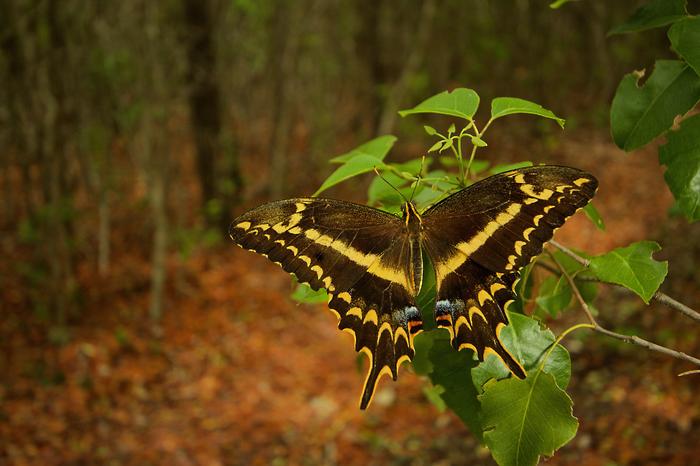
Scientists have recently gained valuable insights into the population dynamics of the federally endangered Schaus’ swallowtail butterfly, an insect whose survival is complexly intertwined with environmental disturbances, particularly hurricanes. This unexpected relationship has emerged from an extensive study that utilized a comprehensive dataset spanning over 35 years, conducted in the sensitive ecosystems of the Florida Keys. The findings underscore not only the resilience of this butterfly species but also the broader implications of environmental disturbances on species conservation.
The Schaus’ swallowtail butterfly, known scientifically as Heraclides ponceana, is endemic to southern Florida and is categorized as one of the rarest butterflies in the United States. One of the earliest insects to be designated on the U.S. endangered species list, the Schaus’ swallowtail has faced significant challenges in its habitat due to urban development and climate-related changes. Conservation efforts have been crucial in ensuring that the last remaining populations are monitored and studied, primarily due to the dedicated endeavors of researchers at the Florida Museum of Natural History.
In a pivotal study led by doctoral candidate Sarah Steele Cabrera, the research team meticulously analyzed long-term population trends of the Schaus’ swallowtail. Initial observations revealed no clear population trends; however, a deeper investigation focused on hurricane activity unveiled a fascinating correlation. Notably, the data indicated that populations of Schaus’ swallowtails tended to rebound following the occurrence of strong hurricanes. This kind of information could lead to a paradigm shift in the way we understand the relationships between natural disturbances and species recovery.
Hurricanes, while inherently destructive, create environmental conditions that inadvertently favor the Schaus’ swallowtail. Following the upheaval caused by a hurricane, the forest ecosystem undergoes significant changes. Trees lose leaves, sunlight penetrates the forest floor, and new growth emerges from previously shaded understory plants. The Schaus’ swallowtail relies entirely on two specific host plants, torchwood and wild lime, which thrive in these post-hurricane conditions. These vital plants provide the necessary food sources for both caterpillars and adult butterflies, illustrating a unique symbiotic relationship between the butterfly and its necessary habitat.
The long-term dataset compiled as part of this research reflects the importance of historical monitoring in ecological studies. The yearly fluctuations witnessed in the populations of Schaus’ swallowtails are typical within the life cycle of many insects, especially given their reproductive strategies and sensitivity to climatic changes. As such, understanding how these fluctuations correlate with significant weather events is paramount for predicting future population dynamics and implementing effective conservation strategies.
The research highlights a crucial aspect of tropical ecosystems, which often remain understudied despite their rich biodiversity. Many species, particularly tropical butterflies like the Schaus’ swallowtail, have complex life cycles and ecological roles. Given their reliance on specific environmental conditions and host plants, the ramifications of climate change and habitat destruction pose a severe threat to their survival. The findings of this study reveal an urgent need for long-term ecological monitoring and research to inform effective conservation methods.
However, the adaptability of Schaus’ swallowtails to hurricanes does not mitigate the risks presented by severe climate events. As climate change progresses, the frequency and intensity of hurricanes may increase, posing a new challenge for the Schaus’ swallowtail, which could find itself unable to recover adequately from more frequent disturbances. The delicate balance of benefiting from certain environmental upheavals while suffering from others exemplifies the complex interplay of ecological dynamics in the face of climate change.
Conservation efforts must take into account these nuanced relationships. Researchers at the Florida Museum have proactively initiated measures to restore and extend the habitat of the Schaus’ swallowtail by reintroducing this butterfly to unoccupied conservation lands, thereby creating new populations that might serve as buffers against potential catastrophic events. This proactive approach aims to establish self-sustaining communities of Schaus’ swallowtails across multiple locations to safeguard them from the effects of a single, intense storm event.
The case of the Schaus’ swallowtail is one of many that exemplify the delicate balance within ecosystems and challenges posed by human activity and climate change. As urbanization continues to encroach upon natural habitats, species that have adapted to intrinsic environmental fluctuations are increasingly at risk from external pressures exacerbated by human action. The ongoing study into the Schaus’ swallowtail emphasizes the importance of maintaining biodiversity and preserves while respecting the inherent complexities of environmental interactions.
Overall, this groundbreaking research provides not only a deeper understanding of the Schaus’ swallowtail butterfly’s dependence on hurricanes for population sustenance, but also delivers a compelling argument for the necessity of long-term ecological studies. The discoveries made through this research serve as a crucial reminder that even within the most challenging environments, life adapts and thrives, and that the interplay of species with their surroundings is vital knowledge needed for future conservation efforts.
Subject of Research: Schaus’ swallowtail butterfly population dynamics in relation to hurricanes.
Article Title: Long-term population dynamics of an endangered butterfly are influenced by hurricane-mediated disturbance.
News Publication Date: 12-Jan-2025.
Web References: Florida Museum of Natural History.
References: Study published in Biological Conservation.
Image Credits: Credit to Florida Museum photo by Kristen Grace.
Keywords: Schaus’ swallowtail, hurricanes, population dynamics, endangered species, Florida keys, long-term study, biodiversity, climate change, conservation biology.
Tags: climate change impact on speciesconservation efforts for rare butterfliesendangered species research Floridaenvironmental disturbances effectsFlorida Keys ecosystem studyHeraclides ponceana survival strategiesHurricanes and butterfly conservationlong-term ecological researchpopulation dynamics of butterfliesresilience of Schaus’ swallowtailSchaus’ swallowtail butterfly habitaturban development challenges for wildlife




